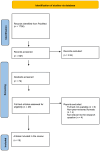Evolving trends in oral cancer burden in Europe: a systematic review
- PMID: 39493458
- PMCID: PMC11527597
- DOI: 10.3389/fonc.2024.1444326
Evolving trends in oral cancer burden in Europe: a systematic review
Abstract
Introduction: Oral cavity cancer (OCC), primarily oral squamous cell carcinoma (OSCC), is a growing concern in Europe, particularly among younger populations. Preventable lifestyle factors and social determinants of health contribute significantly to the disease burden. Limited access to healthcare and delayed diagnoses further complicate treatment and reduce survival rates.
Methods: This systematic literature review adhered to PRISMA guidelines to explore trends in OSCC epidemiology, etiology, diagnosis, treatment, and survival across Europe. A comprehensive search strategy using PubMed, GLOBOCAN data, and the EUROCARE-5 study identified relevant articles focusing on human populations in Europe with a primary interest in OSCC epidemiology. Only peer-reviewed publications in English with full-text access were included.
Results: This study investigated the burden of OSCC across Europe, revealing variations in incidence, mortality, and prognosis. Eastern and Central Europe displayed the highest burden. Males exhibited a significantly higher risk compared to females. Age-related disparities existed in life expectancy and time to achieve favorable outcomes. HPV emerged as a growing risk factor for oropharyngeal cancer. Public health strategies should target modifiable risk factors and improve early detection.
Conclusion: This review reveals concerning disparities in European OSCC. Region, sex, and age all influence burden and prognosis. Future research should focus on controlling risk factors and personalized medicine to optimize treatment. This will lead to a Europe with reduced OSCC incidence and demonstrably better patient outcomes.
Keywords: GLOBOCAN; HPV; epidemiology; incidence; mortality; oral squamous cell carcinoma; risk factors.
Copyright © 2024 Ghanem, Memon and Nagy.
Conflict of interest statement
The authors declare that the research was conducted in the absence of any commercial or financial relationships that could be construed as a potential conflict of interest.
Figures
References
-
- Rezazadeh F, Andisheh-Tadbir A, Malek Mansouri Z, Khademi B, Bayat P, Sedarat H, et al. . Evaluation of recurrence, mortality and treatment complications of oral squamous cell carcinoma in public health centers in Shiraz during 2010 to 2020. BMC Oral Health. (2023) 23:341. doi: 10.1186/s12903-023-03071-2 - DOI - PMC - PubMed
Publication types
LinkOut - more resources
Full Text Sources


